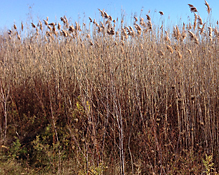Invasive plants
The Grand River watershed has become home to many invasive plant species from around the world. Some, such as garlic mustard, were brought here on purpose for ornamental or culinary use. It's unclear how some others arrived.
These invasive species can crowd out native species by depriving them of light, releasing toxins into the soil or other methods. Once they have spread they can be hard to eliminate, so it's better to control them before they become widely distributed.
Resources
Here are some resources that can help you identify invasive plants and stop them from spreading:
- Grow Me Instead: Beautiful Non-Invasive Plants for Your Garden (Ontario Invasive Plant Council webpage)
- Garlic Mustard: A How-To Guide for Removal (PDF on Ontario Invasive Plant Council website)
- Landowner's Guide to Managing Invasive Plants in Ontario (PDF on Ontario Invasive Plant Council website)
Report invasive plants
If you spot an invasive species in the wild, call the Invasive Species Hotline at 1-800-563-7711 or report it online.
European or common buckthorn
European buckthorn is a shrub that grows so densely that it is replacing native trees. It is common throughout the Grand River watershed. Buckthorn can deprive young maples and other species of trees and shrubs of the light they need. Birds eat buckthorn berries and transport the seeds over long distances.

Garlic mustard
This species was introduced for culinary use in the 1800s and now is a serious weed in open forests where it can completely cover the forest floor, excluding many of the native spring wildflowers. Since it is tolerant of partial shade, it persists in all but the densest forests.
Garlic mustard releases a chemical that poisons fungi in the ground, depriving maple, ash and other hardwoods of nourishment.
It is found throughout the Grand River watershed.

Phragmites australis (common reed grass)
Phragmites is a very tall grass that spreads quickly and out-competes native species for water and nutrients. It is found throughout the Grand River watershed. It releases toxins into the soil that kill surrounding plants. It requires so much water that water levels can drop in a pond or wetland where it takes over. It provides poor habitat and food for wildlife.

Dog-strangling vine
Two Eurasian species - black swallowwort and pale swallowwort - are referred to as dog-strangling vine. It was introduced as a garden plant in the 1800s but has spread through central and southern Ontario. It is found in scattered locations in the Grand River watershed.
It prefers open sunny areas but can also live in shade. It grows up to two metres high by wrapping itself around trees and other plants. The dense stands overwhelm and crowd out native plants and young trees. Leaves and roots may be toxic to livestock. Deer and other browsing animals avoid it, which can increase grazing pressure on native plants. It threatens the monarch butterfly because the eggs they lay on it are unable to survive.

Autumn olive
Autumn olive was planted in Ontario in the 1970s in an effort to improve wildlife habitat, because it produces berries that birds like. However, the plants grow quickly and form dense thickets that hinder the growth of other plants that need lots of sunshine. They can change soil chemistry making it suitable for other invasive species. It is found in much of the watershed, especially south of Highway 401.

Japanese knotweed
Japanese knotweed is a highly problematic invasive species that can grow along watercourses, in forests, shorelines, roadsides, meadows and wetlands. The species can be easily spread to new locations through the movement of small pieces of root or stem. Once established, Japanese Knotweed is extremely difficult to eliminate, often requiring professional assistance over a number of years.
Japanese Knotweed grows so densely that it shades out native plants, eventually replacing them. The plant can also damage buildings and infrastructure with its strong roots and stems which can grow through concrete and asphalt.
Japanese Knotweed is listed as a 'Restricted Species' under the Ontario Invasive Species Act.
CAUTION: Trying to remove the plant by simply cutting or digging may cause it to grow larger and spread further.

Yellow flag iris
This eye-catching species can grow in dense patches in wetlands, ditches and shorelines. It can spread quickly and easily through seeds or pieces of root and once established it provides poor habitat quality for fish, birds and other wildlife species. This invasive species can negatively alter the hydrology of wetlands and reduce their ability to store water during dry periods. Yellow Flag Iris is also poisons to humans and animals if eaten, and the sap can cause skin rashes.
CAUTION: Simply cutting the plant can result in further spread of the plants through movement of pieces of root.

Himalayan balsam
This escaped ornamental plant can grow up to 12 feet tall and can invade areas along the edge of watercourses, shorelines and wetlands. A single plant can produce over 800 seeds allowing the species to quickly spread to new locations. Once established, Himalayan Balsam aggressively outcompetes native plants, reducing biodiversity and impacting habitat quality.
Himalayan Balsam is an annual plant that dies-off each fall. It has a small, shallow root system. These characteristics can leave streams and shorelines where the plant grows vulnerable to erosion.
To control infestations, plants can be removed by hand pulling before they set seeds. Caution must be taken to properly dispose of the plants and not to disperse the seeds.

Contact Us
Grand River Conservation Authority
400 Clyde Road, PO Box 729
Cambridge, ON
N1R 5W6
Phone: 519-621-2761
Toll Free: 1-866-900-4722
grca@grandriver.ca
